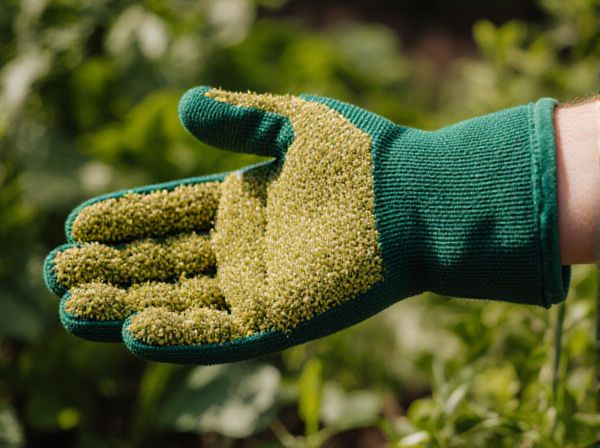
Hand Harvesting vs Mechanical Harvesting Illustration
Hand harvesting allows for selective picking, ensuring only ripe crops are collected, which can improve produce quality and reduce waste. Mechanical harvesting significantly increases efficiency and reduces labor costs, making it ideal for large-scale operations. Choosing between methods depends on crop type, terrain, and economic factors, balancing precision with productivity.
Table of Comparison
| Aspect | Hand Harvesting | Mechanical Harvesting |
|---|---|---|
| Speed | Slow, labor-intensive | Fast, high throughput |
| Labor Cost | High | Low |
| Harvest Quality | Selective, minimal damage | Less selective, potential damage |
| Initial Investment | Low | High machinery cost |
| Suitable Crop Types | Delicate fruits, specialty crops | Grains, large-scale crops |
| Environmental Impact | Low | Higher fuel consumption, soil compaction |
| Efficiency | Low per hour | High per hour |
Introduction to Hand Harvesting and Mechanical Harvesting
Hand harvesting involves manually picking crops, allowing for selective harvesting and reduced damage to delicate produce, often used for fruits and specialty crops. Mechanical harvesting employs machines to efficiently collect large quantities of crops, significantly increasing speed and reducing labor costs, suitable for grains, nuts, and certain vegetables. These contrasting methods offer distinct advantages depending on crop type, scale of production, and desired quality.
Key Differences Between Hand and Mechanical Harvesting
Hand harvesting offers precise crop selection and minimal damage, essential for delicate fruits like grapes and coffee, ensuring higher quality produce. Mechanical harvesting significantly increases efficiency and reduces labor costs but may cause more physical damage and is less selective, making it suitable for large-scale, durable crops like wheat and corn. Key differences include labor intensity, cost-effectiveness, speed, precision, and impact on crop quality.
Advantages of Hand Harvesting in the Garden
Hand harvesting in the garden allows for precise selection and gentle handling of delicate crops, reducing damage and preserving quality. It enables gardeners to selectively pick ripe produce, ensuring maximum freshness and flavor while minimizing waste. This method supports sustainable gardening practices by reducing reliance on heavy machinery and lowering fuel consumption.
Benefits of Mechanical Harvesting for Large-Scale Gardens
Mechanical harvesting significantly increases efficiency in large-scale gardens by rapidly collecting crops, reducing labor costs and time compared to manual methods. Advanced machinery ensures consistent harvesting quality and minimizes crop damage, enhancing overall yield. The automation of mechanical harvesters supports scalability, enabling farms to manage extensive cultivated areas with improved productivity and resource management.
Labor and Cost Comparison: Hand vs Mechanical Harvesting
Hand harvesting demands extensive labor, often requiring skilled workers to pick crops carefully, which increases labor costs significantly. Mechanical harvesting reduces labor needs by automating crop collection, leading to lower overall labor expenses but involves high initial investment in machinery. Cost comparisons reveal that while hand harvesting suits small-scale farms with delicate produce, mechanical harvesting offers cost efficiency for large-scale operations due to faster processing and reduced manual labor.
Crop Quality and Handling: Manual vs Machine Methods
Hand harvesting allows for selective picking, reducing crop damage and preserving quality, especially for delicate fruits and vegetables. Mechanical harvesting increases efficiency but may cause bruising or crushing, affecting the overall quality and shelf life of the produce. Careful calibration of machines and post-harvest handling techniques can mitigate damage but often cannot match the precision of manual methods.
Environmental Impact of Harvesting Techniques
Hand harvesting minimizes soil compaction and preserves surrounding vegetation, reducing ecosystem disruption compared to mechanical methods. Mechanical harvesting typically increases fuel consumption and greenhouse gas emissions due to heavy machinery use. The choice of harvesting technique significantly influences carbon footprint and biodiversity conservation in agricultural systems.
Suitability for Different Crops: Hand or Mechanical?
Hand harvesting is ideal for delicate crops such as fruits, berries, and specialty vegetables where precision and gentleness are crucial to prevent damage. Mechanical harvesting suits large-scale cultivation of grains, root vegetables, and robust crops, offering speed and efficiency in extensive fields. Crop type, field size, labor availability, and cost efficiency are key factors in determining whether hand or mechanical harvesting is more suitable for agricultural operations.
Safety Considerations in Harvesting Practices
Hand harvesting minimizes machinery-related injuries by reducing exposure to heavy equipment, providing a safer environment for workers in complex terrains. Mechanical harvesting increases productivity but poses risks such as entanglement, crush injuries, and exposure to loud noise, necessitating strict safety protocols and protective equipment. Effective training, proper maintenance, and the use of safety guards are essential to mitigate hazards in mechanical harvesting operations.
Choosing the Right Harvesting Method for Your Garden
Hand harvesting allows for careful selection and minimal damage to delicate crops, making it ideal for small gardens and specialty produce like berries and herbs. Mechanical harvesting increases efficiency and reduces labor costs, best suited for large-scale operations with uniform crops such as grains and root vegetables. Consider crop type, garden size, and budget constraints to determine the most effective harvesting method for optimal yield and quality.
Hand Harvesting vs Mechanical Harvesting Infographic

 gardendif.com
gardendif.com